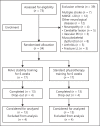Effects of Pelvic Stability Training on Movement Control, Hip Muscles Strength, Walking Speed and Daily Activities after Stroke: A Randomized Controlled Trial
- PMID: 30140119
- PMCID: PMC6103379
- DOI: 10.1159/000486273
Effects of Pelvic Stability Training on Movement Control, Hip Muscles Strength, Walking Speed and Daily Activities after Stroke: A Randomized Controlled Trial
Abstract
Background: Pelvic instability is a common occurrence during standing and walking post stroke. Inappropriate muscle activation and poor movement control around the pelvis lead to difficulty in mobility and daily functioning.
Purpose: The purpose of the study was to examine the effects of pelvic stability training on the movement performance of trunk and lower limb, hip muscles strength, walking speed and daily activities after stroke.
Methods: This randomized controlled trial involved 34 patients aged 56 (11) years with the post stroke duration being 31 (22) weeks. Patients with medical stability, an ability to follow verbal instructions, independent sitting balance and supervised walking capacity were included. The experimental group (n = 13) underwent the pelvic stability training and the control group (n = 13) were subjected to standard physiotherapy for 1 h a day, 3 times a week for over 6 weeks in a stroke rehabilitation setting. Trunk Impairment Scale 2.0 (TIS 2.0), Fugl Meyer Assessment of Lower Extremity (FMA-LE), hip muscles strength (lb.), gait speed, pelvic tilt and modified Barthel Index (MBI) were the outcome measures.
Results: All the measures between both groups were similar at baseline except TIS 2.0 and FMA-LE. Following training, pelvic stability group showed statistically significant improvement (p < 0.05) except MBI and substantial mean changes in the measures of TIS 2.0 (2.12), FMA-LE (5.12), hip strength (lb.) for flexors (4.6), extensors (2.8), abductors (2.58), adductors (2.9), gait speed (0.05 m/s) and MBI (7.74) as against standard physiotherapy group.
Conclusion: Pelvic stability training was found to be beneficial in improving the trunk and lower extremity movement control, hip muscles strength, gait speed and daily activities in stroke.
Keywords: Mobility; Movement control; Pelvic stability; Strength; Stroke.
Figures
References
-
- Lawrence ES, Coshall C, Dundas R, Stewart J, Rudd AG, Howard R, et al. Estimates of the prevalence of acute stroke impairments and disability in a multiethnic population. Stroke. 2001;32:1279–1284. - PubMed
-
- Garland SJ, Gray VL, Knorr S. Muscle activation patterns and postural control following stroke. Motor Control. 2009;13:387–411. - PubMed
-
- Lee D, Hodges P, Principles of integrated model of function and its application to the lumbopelvic- hip region . The Pelvic Girdle. In: Lee D, Hodges P, editors. Churchill Livingstone. ed 3. 2004. pp. pp 41–54.
-
- Karthikbabu S, Chakrapani M, Ganesan S, Ellajosyla R. Pelvic alignment in standing, and its relationship with trunk control and motor recovery of lower limb after stroke. Neurol Clin Neurosci. 2017;5:22–28.
LinkOut - more resources
Full Text Sources
Other Literature Sources














